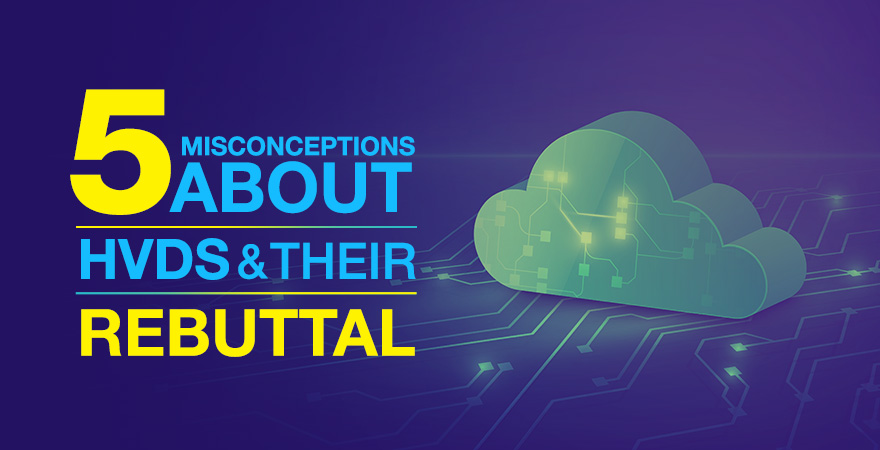You may know a little about Hosted Virtual Desktops or maybe, a lot. But one thing is certain – they’re becoming a seriously hot topic in today’s world. Let’s clear some misconceptions to help you separate facts from hearsay.

Its misconceptions like these that tend to create doubts and hesitation in the minds of those who truly want to harness the power of Hosted Virtual Desktops. At times, the lack of authentic and reliable information about HVDs also creates undue trouble.
So, let’s dive in and clear the five most common misconceptions about the revolutionary cloud powered technology we call HVDs.
Misconception #1 – You do not save money in the cloud.
Actually, one of the main drivers for implementing hosted virtual desktops is cost savings. It’s important to note the difference between hosted virtual desktops (HVD) and virtual desktop infrastructure (VDI).
VDI is when a company wants to virtualize their infrastructure in a private cloud setting. They will buy the servers, storage and manage the infrastructure themselves. HVD is a simple pay-as-you-go subscription model where you don’t incur any upfront Capital Expenditure (CapEx).
With IT hardware part out of the way in HVDs, you also cut down your operating expenses related to IT. Your Cloud Service Provider (CSP) deals with all the underlying hardware that supports your HVD solution, and all this is factored into your cloud bill.
HVD is much cheaper than traditional thick client deployments. Its because unlike an HVD solution, VDI has staggering infrastructure and storage costs on the backend, coupled with incredibly high IT services costs. Although in theory, you can virtualize desktops thru VDI but the costs are much higher as compared to HVD.
Misconception #2 – Implementing the cloud is complicated and time consuming.
A common misconception among IT folks is that implementing desktop virtualization is complex and involves a lot of management. Quite the contrary actually – just ask the law firm we got up and running in a matter of just 3 days!
First, it’s important to note that not all cloud services providers are created equally. If you work with a cloud services provider like dinCloud, you won’t have to worry about license management, end-to-end security, reporting and analytics or patch management etc.
dinCloud is an end-to-end solution provider that takes you along every step of the implementation process. HVDs can simplify your existing infrastructure and management paradigm. Our cloud experts make sure you enjoy a seamless transition to the cloud.
Misconception #3 – One size fits all.
One of the first things you should do is analyze your users. Are they on the road all the time? Are they working late from home? Perhaps a combination of the two in different departments? It’s imperative that you evaluate your users’ work styles to figure out precisely which ones are a good fit for HVD.
dinCloud can help you perform an assessment of your existing user base and provide reports to help analyze an HVD deployment. More importantly, dinCloud can give your users anywhere, anytime access to their data, processes and applications over the cloud.
To maximize the value which our cloud users extract from our solutions, dinCloud offers a wide range of choice within its HVD packages. These incremental packages have been designed to give you the maximum choice possible when choosing from our HVD offerings. Go for a CSP like dinCloud that has plenty of customization in its HVD solutions.
Misconception #4 – License management is no different in the cloud.
Most small to midsize organizations often overlook the complexities of licensing. We would like to emphasize again that not all cloud vendors are created equal. In the complicated world of licensing, dinCloud can help you navigate the rough waters of licensing by giving you access to our team of experts in this domain.
At dinCloud, our foremost endeavor is to save your cloud deployment costs by leveraging any existing licensing agreements you may already have. Our experts will also ensure you are not being subjected to any licensing costs that you don’t actually need.
We’ve seen organizations time and again make this mistake, and quite literally, pay the price. For example, you need a VDA license to have an HVD solution on top of any Windows OS license you may have, and we are there to help you in situations like these.
Misconception #5 – End user experience is worse in the cloud.
We at dinCloud challenge anyone who says this to do a side-by-side comparison with our HVD and a physical PC. Does your physical PC never crash? Your Internet Explorer never freezes? Or your OS never gets stuck at a blue screen? We all have witnessed these time and again.
The cloud is not some magical solution that can solve all your problems, but it certainly can solve most of them. Speaking from personal experience, my end user experience has been phenomenal and I’m addicted to my HVD!
What most people tend to overlook when evaluating HVD performance is that its highly dependent on your internet connection. If you feel an HVD is not delivering the desired performance, there may be some issue with the internet or your endpoint device.
dinCloud has a dedicated monitoring team for its cloud solutions. We constantly monitor, track and benchmark the performance of our HVDs against the highest industry standards. Remember, there are more variables to an HVD solution than your cloud provider alone.
Stay mobile my friends and enjoy On the Go productivity with dinHVDs!
For more information on our Cloud Solutions, please visit our Hosted Virtual Desktop page or Request Information to speak with a cloud specialist.


